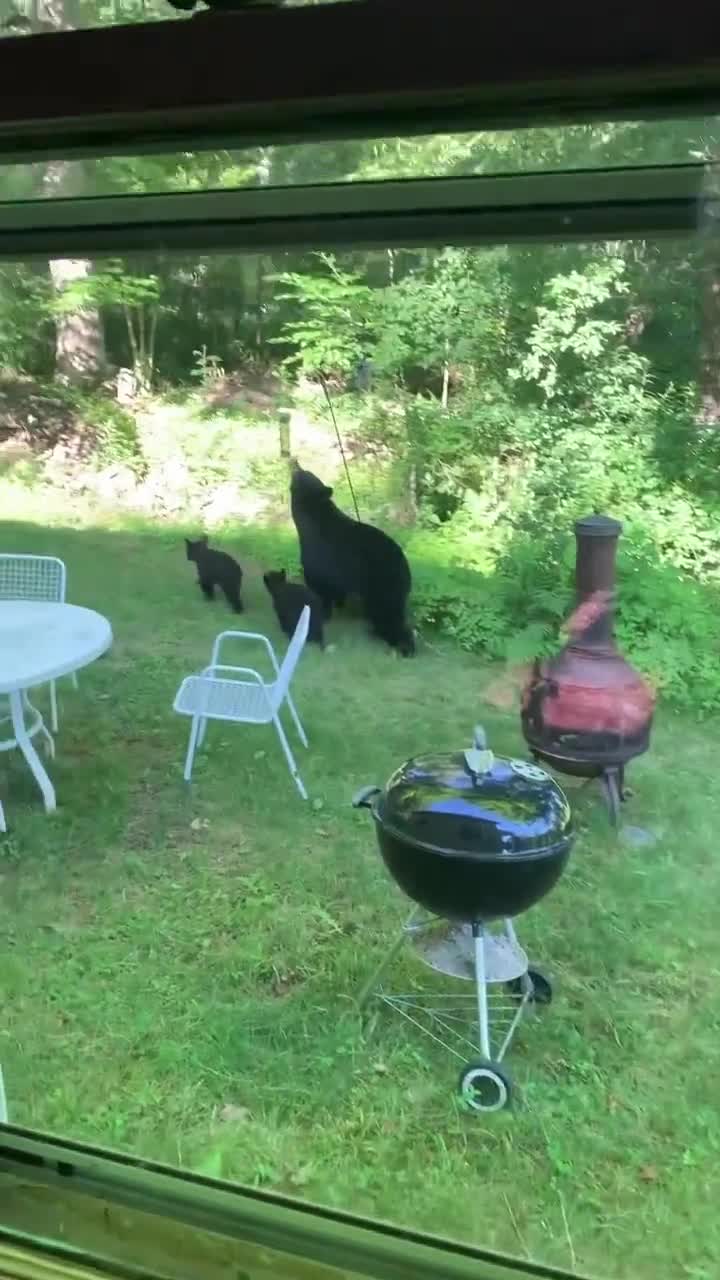It was October of 2023 when Rebecca Boyle, now 44, a science journalist and book author in Colorado Springs, Colorado, learned that a bear could open her front door. It was around 10 o’clock at night and she and her husband were getting ready for bed. Their daughters, then eight and two, were safely asleep. Out of nowhere, their doorbell camera went off, pinging Boyle’s husband’s phone.
The video showed a black bear, standing at the storm door, which wasn’t locked. “The bear walks up, sniffs the door, stands up on its hind legs, turns the door latch and pulls it open,” Boyle says.
Her husband raced to the front door, and the bear fled. Predictably, Boyle was a bit unsettled. She hadn’t expected the bear to act quite so much like a person. “It knew what a door was, how to use it,” she says.
That wasn’t the family’s first close encounter with a bear: Right after they moved to their new development, in the spring of 2020, another bear walked into the open garage after Boyle had brought in the groceries. “It opened my car door and slobbered all over the seat,” she says. Boyle saw the video on her phone, and hit the panic button on her car key. “You hear the car alarm noise,” she recalls. “And then the bear was tearing away at full speed.”
Like Boyle, many people across the United States, especially in forested areas, are encountering more black bears more often (on the other hand, grizzly bears, also known as brown bears, tend to avoid human interaction). But these bear sightings aren't happening at parks or in zoos. Instead, the bears are sauntering into their backyards, garages, even kitchens. The bears aren’t there to attack humans — they're there to haul down bird feeders, raid trash cans, rip into chicken coops and even raid the ice cream in the fridge.
Long Winter Naps are Getting Shorter
It may feel like a home invasion, but like many species that have been displaced, bears were here first. In the 18th and 19th centuries, humans hunted them out of many parts of the East Coast and Midwest. But as forests regrow, bears are coming back—and finding that what was once forest is now a subdivision. Not surprisingly, climate change plays a role, too.
When bears bed down for the winter, and when they get up, depends almost entirely on the weather. Climate change is bringing shorter, warmer winters, and for bears, that means shorter hibernation periods, notes Briana Abrahms, 39, a wildlife ecologist at the University of Washington in Seattle. “They’re going to be more active for longer parts of the year,” she says, and more likely to run into people.
Of course when a bear wakes up, it’s very hungry. If bears come out of hibernation early, the plants they need to feed on might not be ready. “That can lead to food shortages, which may lead them to seek out alternative food sources from humans,” says Abrahms.
Climate change also makes food sources less reliable, explains Katherine Kurth, 32, a biologist with the Oak Ridge Institute for Science and Education. There are more droughts, more wildfires, even more weird late-season freezes. All of these “can reduce the abundance of key foods like berries and nuts,” Kurth says. Without wild food, bears “expand their foraging areas or seek alternative food sources often bringing them closer to humans” — and their garbage
Seeing Bears In New Places
Cina Marciniak, 68, a cook in Ossineke, MI, has lived in the Michigan woods for 40 years, but had never had bear trouble until the spring of 2022. Her husband, Steve, had gotten into bird watching, and the feeders proliferated, some with seeds for songbirds and some with suet for woodpeckers.
One morning, Steve found one of the bird feeders destroyed. Curious, he put out a few of his hunting trail cams. The culprit was caught on camera. A mama black bear — likely close to 300lbs — and three cubs, feasting on birdseed. “As determined as he is with his birds, he decided to fix the bird feeder,” Marciniak recalls. The bears tore it down again. And again. “The mama bear actually bent the pole,” she says.
Seeing bears—cubs playing, or a bear eating while you’re on a hike—can be lovely. Male black bears can weigh between 130 and 500 lbs, and females 90-350 lbs. They are easily as tall as a person when they stand on their hind paws. They are beautiful, but they aren’t always gentle. They are much more powerful than humans, and can sprint at 35 miles an hour. A bear that is cornered, or a mother defending her cubs, can charge, and their paws end in large, thick, sharp claws that they usually use for climbing trees. They also have a lot of teeth. Marciniak began to worry about her grandkids, living in a house just across the cul-de-sac. “They play outside,” she explains. “The kids that go to junior high, they get on a bus just after six [am].”
The Marciniaks hadn’t seen the bears before, but the bears were probably always there. Bears have “been found in essentially every county in Michigan,” explains Cody Norton, 34, a bear, furbearer and small game specialist at the Michigan DNR.
In fact, Norton and his colleagues now get four times the number of bear complaints than they did just a few years ago. In the early 2020s, the DNR fielded about 200 nuisance calls a year from the Lower Penninsula, Norton says. Some of that, he notes, is the bigger population of bears. In 2022, there were more than 1,700 bears, or about one bear per 10 square miles.
It’s more bears, but there are also more than 10 million people in Michigan, and the population is steadily increasing. So more people are seeing bears for the first time. “We get doorbell video footage sent to us quite often,” Norton notes. Before the video doorbell, he says, the bears probably went through the property without anyone realizing. Now? “They end up picking up things that [people] just didn’t know were there, and now it’s a problem.”
In other places, like Connecticut, bears really were completely eradicated. And now, they’re coming back. “A bear has been sighted in every town in the state of Connecticut,” says Tracy Rittenhouse, 47, a wildlife ecologist at the University of Connecticut in Storrs. The population is expanding in from the west. Black bears have territories, and females tend to set up shop in territories near their mothers and have their cubs there. Males, however, go further afield. “So males will sometimes go for a walk throughout Eastern Connecticut, and then eventually they're going to look for females, and they'll move back towards where the females are,” she explains.
Along the way, they find that places that used to be forest are full of people. “Bears actually really like the mixture of forest and houses,” Rittenhouse says. The forest provides safety. The houses provide food, something a bear is always interested in.
In the spring or summer, a bear needs about 5,000 calories a day. But black bears hibernate—settling down and slowing down, not eating or drinking for the winter. So in the fall, they need 20,000 calories per day to prepare for the winter. Usually, they get that in the form of nuts, berries, plants, and insects. They’ll eat smaller animals too, alive or dead. And of course, trash, birdseed, or even dirty grills start to smell pretty good.
Finding food means coming close to people. Joanna Langfield, a film critic for The Movie Minute, has had a condo in northwest Lichfield county, CT, since 1988. Condos mean group garbage, and in 2015, residents began to notice bears. “Our neighbors had kids who just didn't care about garbage responsibility, you know, so the bears knew where we lived and would come because they knew they could have easy access,” Langfield says. She took pictures of bears hauling garbage bags off into the forest.
Langfield, who loved long walks with her tiny Yorkie, Teddy, began walking with her head on a swivel. More than half of incidents between humans and bears between 2010 and 2015 also involved a dog — often one not on a leash. A dog often doesn’t win that fight, 46% of them get injured or killed, and 62% of their owners ended up injured when they tried to help their pooch.
Bearing with us
Back in Michigan, Cina Marciniak’s husband continued his battle with the bear, watching his feeders come down, over and over. Finally, the couple were fed up, and called the Michigan Department of Natural Resources. “They pretty much told him to stop feeding the birds,” Marciniak says. “He's a stubborn man, and he wasn't about to do that.”
But not feeding the birds in spring is the general advice, says Norton. What is birdseed, after all, but unprocessed nut butter? “A lot of people like to take down bird feeders at night when they think bears are going to come around and put them back up,” he says. But “during the day, the birds sift through the seeds, knock down all their least favorites, and then there's a pile of bird seed every night.” A dirty grill, open trash, or leftover pet food from feeding pets outside will also tempt in a bear. “Anything that smells or tastes good to a human in general, that’s something that is going to bring in a bear,” he says.
People might want to move to woody parts of Connecticut, Colorado, or Michigan because they want to be close to wildlife. But often, they don’t realize they’re moving into bear country. Anna Miller, 41, a recreation social scientist at Utah State University in Logan, has been working with Norton to understand how people are living with bears in Michigan—especially in the western part between Traverse City and Grand Rapids. “There's a big summer vacation industry, especially up around Traverse City,” Miller says. “But there's a lot of people also moving to this area, because they can remote work now, or they're retiring, and they're just not really familiar with bears or what it means to live in a rural area.”
“A lot of people don’t even realize they live in bear country,” says Dan Gibbs, the black bear program leader for the state of Tennessee in Morristown. Many people just don’t know that bears are around, because bears don’t actually want to spend time around people — just their food. “People typically don't get injured by bears because the bears are being predatory,” Gibbs says. “They get injured by bears because the bears are surprised.” The bear went after something on the porch, say, and someone stepped outside to find the source of the noise.
Gibbs and other state biologists have teamed up to create BearWise, a national education program that helps people live peacefully with bears. Its website offers easy tips and short brochures on everything from locking up trash to how to grow bird-friendly gardens—and avoid birdseed. “We're starting to see a lot of change,” he says. “A lot of people are recognizing that, hey, this isn't a bear problem, it's a people problem.” Bears and people are always going to run into each other, but a little change could make it less likely. “The key is trying to get people to quit being reactive, [and be] proactive.”
Boyle had grown up in Colorado, she’d known that bears would be a possibility. She keeps her golden retriever, Sunshine, in the yard, and checks the yard before she lets her out. The family doesn’t feed the birds. And Boyle has taught her daughters what to do around bears. “I learned this as a kid too,” she says. “If you see a black bear, you don't run, you don't do anything. You slowly walk backward away and go back inside.”
In Michigan, the Marciniaks hit upon their own bear method. A strong, thin clothesline, too thin for a bear to crawl out on. It’s suspended between two large trees about 90 feet apart. The line “has a crank on it where he can pull it down to fill the bird feeders and crank it back up,” Marciniak says. So far, it’s pretty bear-proof.
In Connecticut, the family with bad trash habits moved out. Langfield’s condo got better trash cans. The condos switched from a wooden garbage shed to a metal shed, with handles only humans can use. It can be a little tricky for the humans to open, but it’s worth it. “The bears can't get in there, and they've stopped coming because they don't get any food there.” A little knowledge can mean a lot less worry, and a lot fewer bears.
How NOT to Attract Bears
Here are a few simple tips to keep bears from exploring your backyard.
- Remove bird feeders: Taking bird feeders down during the spring and fall when bears are most active can keep them away. Growing bird-friendly flowers and adding birdbaths can keep birds coming without bear guests.
- Secure food: Bears smell better than dogs can, and have a good memory. If they get food once, they’ll remember where. Make sure garbage, food, compost, or recycling is covered and locked.
- Secure pet and chicken feed: Keep pet food indoors, and feed animals indoors, too. Leftover food and its smells can bring in bears.
- Clean the grill: Burned bits on a grill are a big bear draw, clean and lock it up after use.
- Keep dogs on a leash: More than half of the incidents involving people and bears also involve a dog. Unleashed dogs may chase, corner, or try to play with a bear, and bears don’t want to play.
- Tell your neighbors: Make sure everyone is locking up their trash, and is as up to date on best practices as you are.
- And don’t feed the bears. On purpose, or by accident. Keep your distance.

Bethany Brookshire is an award-winning science journalist who writes on human-animal conflict, ecology, environmental science, and neuroscience. She hosts the podcast Science for the People, and her work has appeared in _Science News, Science News for Students, The Washington Post, Slate, The Guardian, The Atlantic and other outlets.



















